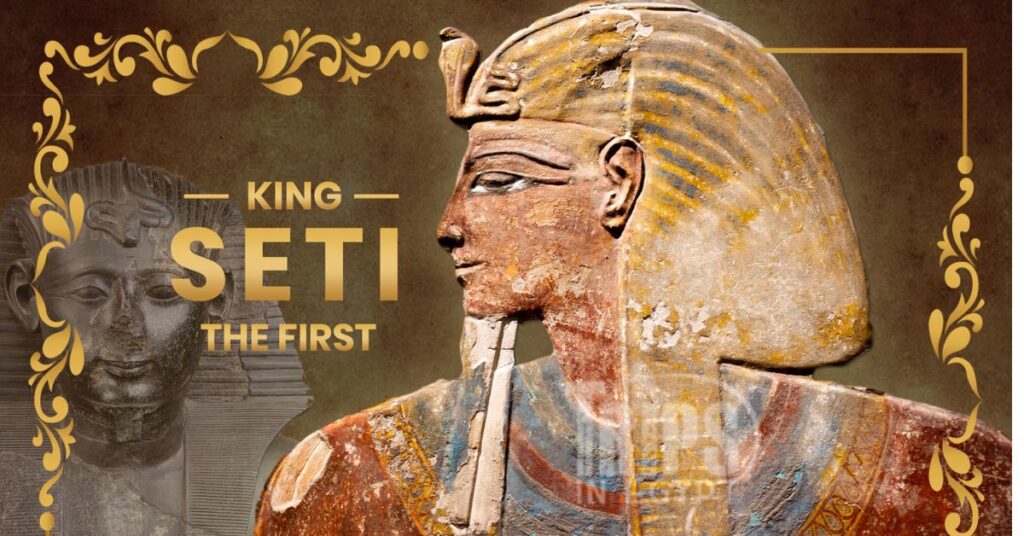Ancient Egypt, a civilization renowned for its grandeur, owes much of its legacy to powerful rulers who safeguarded its borders and preserved its culture. Among these rulers, Seti I stands out as a formidable pharaoh who not only protected Egypt from external threats but also restored stability after years of political turbulence. Known as the Guardian of the Empire, Seti I’s reign was a period of revival, military strength, and architectural brilliance.
Early Life and Rise to Power
Seti I was the son of Ramses I, the founder of the Nineteenth Dynasty, and Queen Sitre. Though his father ruled briefly, Seti inherited a kingdom that needed strong leadership. With determination and vision, Seti ascended to the throne around 1290 BCE, bringing with him both military expertise and a commitment to restoring Egypt’s former glory. His name, “Seti,” meaning man of the god Set, reflected his connection to the powerful deity of strength and chaos.
Military Campaigns: Defending Egypt’s Borders
One of Seti I’s most defining characteristics was his role as a military leader. At a time when Egypt faced threats from the Hittites, Libyans, and rebellious Canaanite states, Seti I took decisive action to secure Egypt’s frontiers.
- Against the Hittites: Seti I led campaigns into Syria and Palestine, capturing key territories that strengthened Egypt’s control over trade routes.
- In Libya: He defended Egypt’s western border against Libyan incursions, ensuring stability in the region.
- In Nubia: His campaigns in the south secured Egypt’s dominance over Nubia, a land rich in resources like gold.
These victories not only expanded Egypt’s influence but also reinforced its image as a dominant power in the ancient world.
Domestic Achievements and Stability
While Seti I is often celebrated for his military prowess, he was equally dedicated to restoring Egypt internally. After the political unrest of the Amarna Period, he worked to revive traditional religious practices and reinforce the role of the priesthood. He honored Egypt’s gods, particularly Amun, Osiris, and Ptah, helping to restore the cultural and spiritual fabric of the nation.
Seti’s administration emphasized law, order, and prosperity. Records from his reign suggest that he valued justice and took measures to protect the welfare of his people. His ability to balance military campaigns with domestic reforms earned him lasting respect as a guardian of Egypt’s stability.
Architectural Legacy
Seti I’s reign is also remembered for its remarkable architectural achievements. He initiated grand building projects across Egypt, many of which reflected his devotion to the gods and his vision of a strong empire.
- Temple of Abydos: Perhaps his most famous contribution, the temple at Abydos is renowned for its stunning reliefs and the Abydos King List, a chronological record of past pharaohs. This temple remains one of the most beautifully decorated in all of Egypt.
- Karnak Temple: Seti I expanded the temple complex at Karnak, adding impressive pylons and halls that showcased his power.
- Tomb in the Valley of the Kings: His tomb (KV17) is one of the longest and most elaborately decorated in the Valley of the Kings, reflecting his reverence for the afterlife.
Through these projects, Seti I ensured that his reign would be remembered not only for military might but also for cultural and artistic excellence.
Legacy and Succession
Seti I’s reign set the foundation for Egypt’s stability during the Nineteenth Dynasty. He was succeeded by his son, Ramses II, also known as Ramses the Great, who carried forward his father’s vision and expanded Egypt’s legacy even further. While Ramses II often receives more attention in history, it was Seti I who laid the groundwork for this golden era.
Conclusion
Seti I rightfully deserves the title of the Guardian of the Empire. Through his military campaigns, he secured Egypt’s borders from formidable enemies. With his dedication to religion and governance, he restored cultural traditions and stability. And with his architectural contributions, he left behind enduring symbols of Egypt’s greatness.
His reign was a balance of strength and wisdom, making him one of the most respected pharaohs in Egyptian history. In both war and peace, Seti I safeguarded Egypt’s empire, ensuring its prosperity for generations to come.





